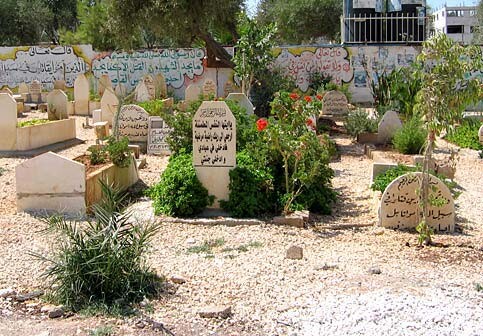Palestine Report Gaza City, Gaza Strip 16 September 2004

A martyr’s cemetery in Jenin (Photo: Rima Merriman)
On September 10, after an Israeli incursion into the northern Gaza Strip that had left at least five dead and dozens wounded, I went to a Gaza City cemetery to look for a young gravedigger.
I had met Mossab, a slim 18-year-old boy from Gaza City, a week earlier. He had long ago dropped out of school to pursue a profession that appeals to very few people, but which is catering to more and more youngsters in Gaza.
In the city’s Sheikh Radwan cemetery, Mossab, along with several other boys, was employed to dig, guard and take care of the graves of the men, women and children that pack the graveyard.
The cemetery covers a white sandy hill surrounded by a low graffiti-covered wall that was once white but has now turned yellowish after years of exposure to car fumes. Prickly pear cactus plants dot most of the cemetery.
Mossab was a veteran among the boys. He had worked at the graveyard for seven years during which time he had even had to bury some of his own friends. Leaning on one of the tombstones, Mossab had pointed out two graves on the other side of the cemetery. “They were my classmates. I buried them last year.”
The two, 16 and 17 years old, were shot dead when, armed with only a knife, they had attempted to infiltrate a heavily fortified Jewish settlement in the northern Gaza Strip. They had not been affiliated with any faction. As we walked towards their graves, Mossab, carrying a shovel on his shoulder, remembered his shock when he had learnt of their deaths. They were the hardest graves he had ever had to dig, he said.
Most people think of grave digging as a gloomy profession. But the young gravediggers at Sheikh Radwan considered their work honorable, especially since, in the words of Mossab, they have “the honor of burying the martyrs the Israelis kill.” The older boys will dig the graves and the younger ones help pile up the sand to cover it after the body has been laid to rest. The boys also help spray water on the graves and replace dead flowers, as well as chasing the herds of sheep and goats away that are attracted to the flora at the cemetery.
“I know that someday I’m going to die, and that’s why I want the cemetery I’m buried in to be clean and tidy,” said Sameer Ghaben, 12, that day as he hurled some stones at two trespassing goats to chase them away.
Ghaben said he comes to the cemetery several times a week, “because my grandfather and uncles are buried here.” In a quiet whisper he confided that he always leaves before sunset because he’s afraid of snakes. The snakes are a problem, acknowledged Mossab, who was bitten once in the cemetery, but while it was painful, the snakes are not poisonous, he reassured the younger boy.
Nor was Mossab bothered by the company of the dead. “Ghosts are old stories our mothers and grandmothers used to make up to frighten us,” he grinned when asked.
For Mossab, grave digging had become his life. He had, he said, dug over 400 graves, and earned a reputation as a seasoned grave digger who was sometimes even specifically requested by relatives of the dead.
Mossab took up grave digging after repeatedly failing to pass his school exams. It soon became his main source of livelihood. He earned less than $10 a day but had more experience than the many boys who come to the cemetery during their summer vacations. Many youngsters choose the job, because they are almost guaranteed employment at any time. Experienced gravediggers often live with their families in small tin shacks inside the cemetery itself, rather than in the nearby residential neighborhoods. Mossab was still too young for that.
“I’m staying at my parents’ house at the moment, but I might think about building a shack here, since I spend most of the day and parts of the night here,” he said, as he bent down to remove some weeds from one of the graves. “I think after seven years I have developed a connection with the cemetery. I would prefer to be buried here,” he added.
He was confident of his employment at the cemetery for as long as it was open, though he didn’t believe that would be too long. Since the outbreak of the Intifada in September 2000, the Sheikh Radwan cemetery has witnessed a steadily increasing flow of bodies, officially becoming the Gaza Martyrs’ Cemetery. Over 3,000 Palestinians have been killed in the past four years, and over 1,000 of those were from the Gaza Strip. The cemetery is filling. “We have already started burying bodies on top of old graves. This place will close soon because of the Israeli attacks.”
At one corner of the cemetery, Mossab led me to a few cracked tombstones. “They didn’t spare even the dead,” he said, referring to a recent Israeli air strike on a building near the cemetery, which led to the damages.
Having interviewed Mossab at length about his work, I returned on September 10 to see him. But when I asked for him I was met by silence. A tiny dark-skinned boy in his early teens led me instead to a grave, its soil still wet with sprayed water and too recently dug to have a tombstone.
“This is Mossab,” said the young gravedigger, almost spitting out the words. “The Israelis killed him last night when he was at his uncle’s house in Beit Lahiya.”






